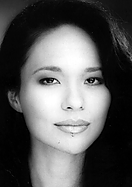
Elizabeth Lindsey:
"We need to be able to develop our voices so that we are
depicted more authentically."

Elizabeth Lindsey:
"We need to be able to develop our voices so that we are
depicted more authentically."
The 26-minute film by actress-writer Elizabeth Lindsey will air on nearly all PBS stations May 23 at 9 p.m.
The 21-minute original documentary featured at last year's Hawaii International Film Festival has been expanded to fit the half-hour programming format. The cost of producing the additional five minutes and marketing the film for PBS was sponsored by Pacific Islanders in Communication, a nonprofit national media arts organization based in Honolulu.
"Then There Were None" tells the story of the dramatic drop in population of full-blood Hawaiians from 500,000 in 1778 to 8,711 in 1993. Demographers predict that by the year 2044 no full-blood Hawaiians will be left.
The film uses archival stills and film footage along with ancient chants, period music and narrative by Lindsey to tell the story. After seeing Lindsey's film PIC decided it wanted to be involved in ensuring that communities with large Polynesian populations saw the documentary, said Lurline Wailana McGregor, PIC's executive director.
Final cost of the project, including production, approvals for use of archived music and photos, and promotion, has not yet been determined, but Lindsey and McGregor estimate it will cost more than $120,000.
Public television's decision to broadcast the film nationwide in prime time is "simply amazing," Lindsey said.
The additional footage makes the documentary "better and stronger because it is now even more personal than the original," she said. Lindsey has included interviews with her own family in the expanded version.
At first an additional five minutes of interviews was tacked on at the end of the original, but it didn't work well because many question within the piece remained unanswered, McGregor said.
So Lindsey suggested adding information at several points throughout the film.
The project was completed in January in Los Angeles. McGregor then sent it to PBS in Washington, D.C., for prime-time consideration. PBS approved the scheduling in February.
To take advantage of "this momentous event," PIC has organized a sort of national tour prior to the PBS broadcasting for the film in about a dozen cities with large populations of Pacific islanders. Lindsey will attend most of these screenings, McGregor said.
"We'll bring the film to these communities, introduce ourselves, and explain what Pacific Islanders in Communication does," McGregor said. "We want to help empower our communities."
In each location PIC representatives and Lindsey will be hosted by Hawaiian civic clubs. The film also will be screened at the Smithsonian Institution in Washington, D.C.
"As an organization, we have always reached out to the Pacific for filmmakers ..." McGregor said. "This is the first time we have gone in the other direction.
"(PIC) exists to develop stories by and about ourselves, and we need to convey this mission to the people who need help the most. We want people to see the difference between a movie made by Pacific islanders about Pacific islands and a movie made by Hollywood that portrays us in their image."
It's time for Pacific islanders to take control of their filmmaking destiny, Lindsey added.
"We always wait for Hollywood to come to us ... to make the decision to come here to tell our stories," she said. "But we need to be able to develop our voices so that we are depicted more authentically and accurately, to find our own way within the filmmaking community."
For more information call 591-0059.